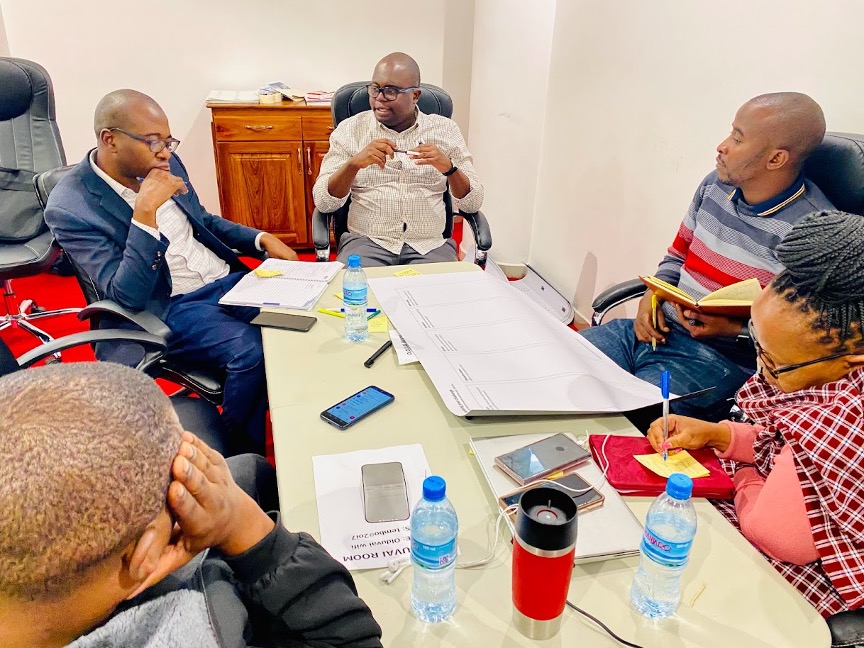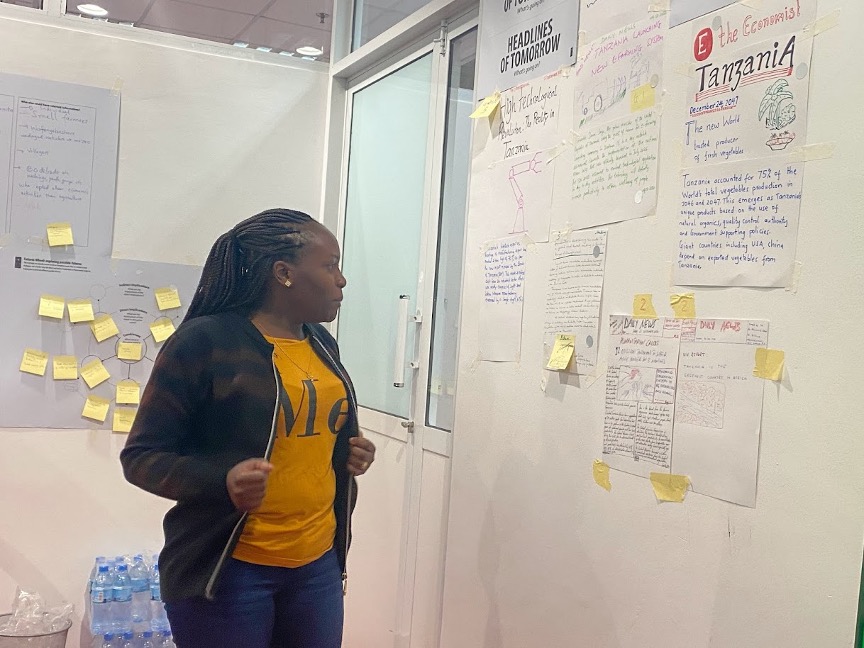Embedding Strategic Foresight into Tanzanian National Development Planning
February 21, 2023
Only through ongoing exploration and global dialogue will humanity be able to imagine the kinds of futures that are possible and design policies today that help shape the future that we want.
Duncan Cass-Beggs, Senior Counsellor for Strategic Foresight, OECD

During the session, a diverse group of participants engaged in a variety of foresight exercises.
A group of experts gathered to explore how strategic foresight can be integrated into the development of the nation's long-term vision. With a focus on leveraging foresight methodologies to anticipate and respond to future challenges, the session aimed to provide practical insights on how to embed a forward-looking approach into decision-making processes and drive tangible progress towards the realization of Tanzania's Vision 2050.
As the world continues to face complex and rapidly changing challenges, it is increasingly important for nations to be proactive and forward-looking in their planning and decision-making. In light of this, the United Nations Development Programme (UNDP) accelerator lab, in collaboration with UNDP’s Bureau for Policy and Programme Support (BPPS), recently hosted a high-level, 2-day interactive session in Tanzania on "How to embed strategic foresight in national development planning." The session was led by the National Development Planning Directorate, which serves as the Tanzania Development Vision 2050 secretariat under the Ministry of Finance and Planning (MOFP). The training aimed to provide participants from various ministries and departments with an understanding of the benefits and tools of foresight and how they can be effectively integrated into the development process of the vision. The session was attended by thirty one participants. The Tanzania Vision 2050 will replace the Tanzania Vision 2025, which is the long-term development plan for the country of Tanzania. It was created with the goal of transforming Tanzania into a middle-income country by the year 2025. The vision outlines several key development areas, including economic growth and diversification, infrastructure development, human capital development, and good governance. The vision is intended to guide the government and other stakeholders in shaping the country's future and realizing the aspirations of its people. The vision also seeks to address some of the challenges faced by the country, such as poverty, inequality, and lack of economic opportunities. The development process for Vision 2050 is lengthy and all-encompassing, providing ample opportunity for the application of strategic foresight tools and methods.
Tools and Methods of Foresight
Foresight is a process of systematic and structured exploration of future possibilities and trends that enables organizations and governments to anticipate and prepare for potential challenges and opportunities. By thinking beyond the present and considering a range of future scenarios, foresight helps embed a long-term perspective into planning and decision-making. The role of foresight in Tanzanian programming circles and the world at large is becoming increasingly important as we witness accelerating technological transformation brought about by the Fourth Industrial Revolution (4IR), demographic and environmental shifts, such as recent water shortages in Dar es Salaam, and other challenges such as rising social, political, and geopolitical uncertainties that are combining to create potentially unprecedented global challenges. In this era of rapid change and increasing uncertainty, organizations and governments are looking for ways to better anticipate, prepare for, and adapt to the future.
The session that took place in Arusha City (Northern Tanzania) introduced participants to various tools and methods used in foresight, including scenario building, trend analysis, and stakeholder engagement. Scenario building, for example, involves creating stories about possible future developments, which can help identify and prepare for potential challenges and opportunities. Trend analysis, on the other hand, involves studying and monitoring relevant trends and drivers of change, which can provide valuable insights into the future. It's important to remember that multi-stakeholder engagement was key to making sure that the foresight process includes and reflects the views and needs of different groups within government.

Participants engaging in the "Headlines of Tomorrow" foresight exercise.
Advantages of Foresight in National Development Planning
Foresight has numerous benefits when it comes to national development planning. Firstly, it helps to embed long-termism into the planning process, which is essential for sustainable development. By considering a range of future possibilities, foresight enables governments to anticipate potential challenges and opportunities and to make plans that are flexible and responsive to changing circumstances.
Secondly, foresight enables governments to anticipate and prepare for disruptions, such as natural disasters, technological changes, political upheavals, and economic shocks. By thinking about these problems ahead of time, governments can be better ready to respond and lessen the effect they have on the population.
Finally, foresight helps ensure that the planning process is inclusive and representative of the views of different groups. By including a wide range of stakeholders, governments can learn more about the future and make sure their plans take into account the needs and points of view of different groups.
"Foresight is a critical tool for economic planning, allowing us to anticipate future trends, challenges, and opportunities. ""By embracing foresight in Tanzania, we can make informed decisions that promote sustainable and equitable growth, creating a brighter future for all." Ellykedo Ngonyani, Principal Economist, MOFP, Tanzania
Weaknesses and Strengths of Foresight
Like any process, foresight also has its weaknesses and strengths. One of the weaknesses of foresight is that it can be resource-intensive and time-consuming. In addition, there is always a risk that the predictions made during the foresight process may not come to fruition. However, despite these weaknesses, foresight has many strengths, including the ability to promote a long-term perspective, to anticipate and prepare for disruptions, and to ensure the inclusivity of the planning process. Moreover, the use of foresight can also lead to increased innovation, as it encourages organizations and governments to think creatively about the future.
Lessons learnt
Based on the insights gained from the session, the following general recommendations can be made:
- Include foresight in the planning process. Governments should use foresight as a key tool in their national development planning process to help them predict and prepare for possible problems and opportunities.
- Establish a dedicated foresight unit: Governments should consider establishing a dedicated foresight unit within their Ministry of Planning and Finance to lead and coordinate the foresight process.
- Engage stakeholders: To make sure the foresight process is inclusive and representative, governments should involve a wide range of stakeholders, such as civil society organizations, the private sector, and academic institutions.
- Use a variety of tools for foresight: Governments should use a variety of tools for foresight, like scenario building, trend analysis, and stakeholder engagement, to get a full picture of the future.
- Watch trends and the things that cause them to change. Governments should constantly watch and analyze trends and the things that cause them to change so they can spot potential problems and opportunities.
- Build partnerships: Governments should form partnerships with other countries, international organizations, and the private sector to improve the process of foresight and encourage knowledge sharing.
- Provide training and capacity building: Governments should invest in training and capacity building for government officials and stakeholders to increase their understanding and use of foresight.
- Review and update the foresight process regularly. To ensure that the foresight process remains relevant and effective, governments should regularly review and update their foresight processes.
- Incorporating strategic foresight training as a regular component in the professional development programs for government staff will enhance their ability to anticipate and respond to future challenges and opportunities.
In conclusion, the integration of foresight into national development planning has the potential to greatly enhance the ability of governments in Africa to anticipate and prepare for potential challenges and opportunities and to promote sustainable development. Following these recommendations, governments can ensure that their planning is proactive, forward-thinking, and reflective of the needs and perspectives of various communities, thereby accelerating the achievement of global goals.
Authored by:
Amon Manyama, Head of Programs, UNDP Tanzania
Ellykedo Ngonyani, Principal Economist at the Ministry of Finance and Planning, Tanzania
Peter Nyanda, Team Lead, Accelerator Lab Program, Tanzania
Special thanks to:
Aarathi Krishnan, Senior Advisor on Strategic Foresight at UNDP

 Locations
Locations